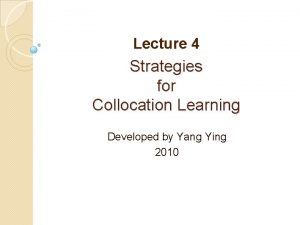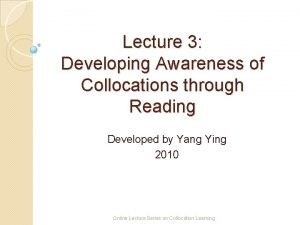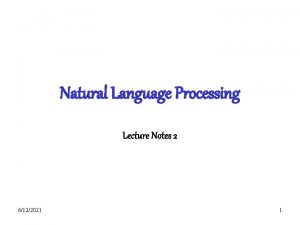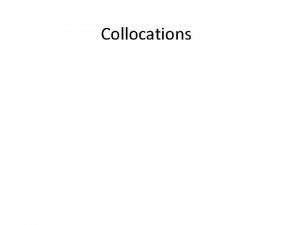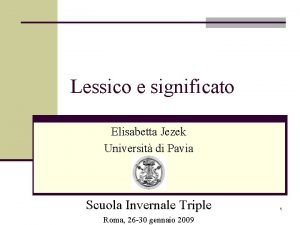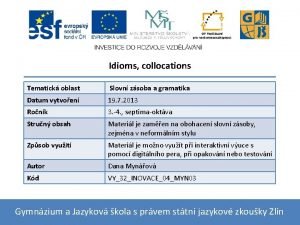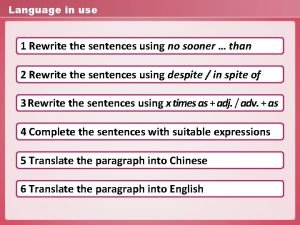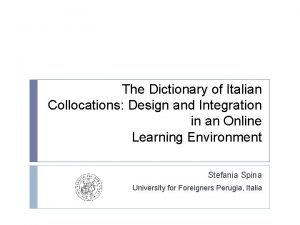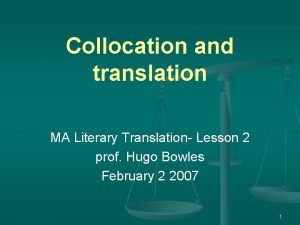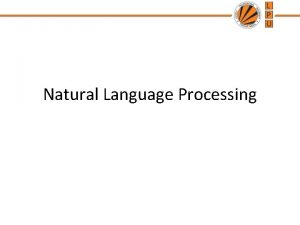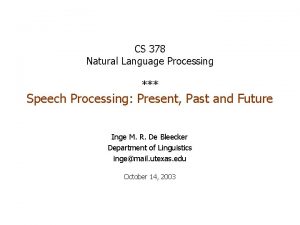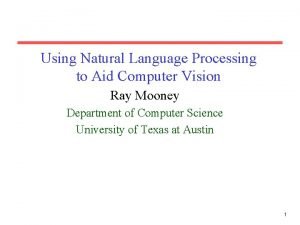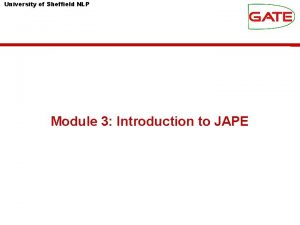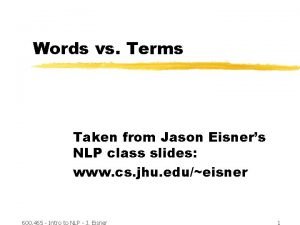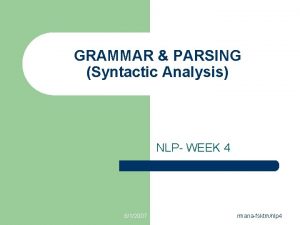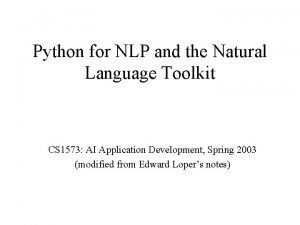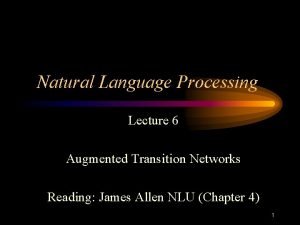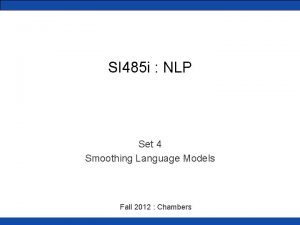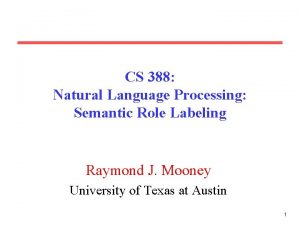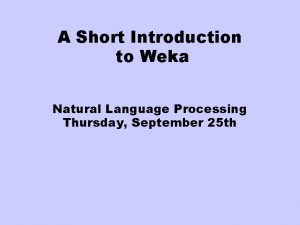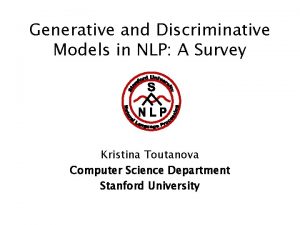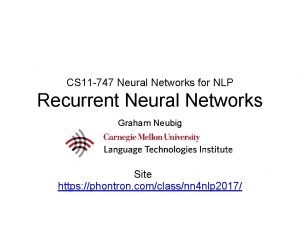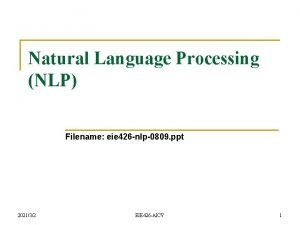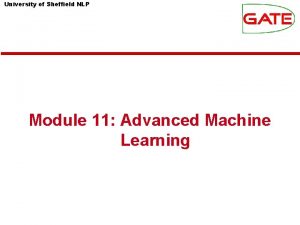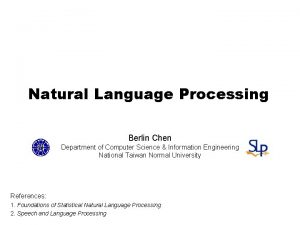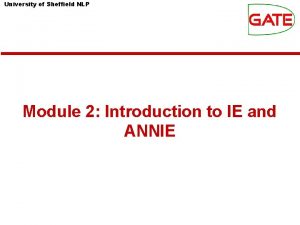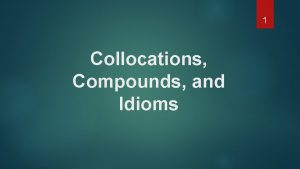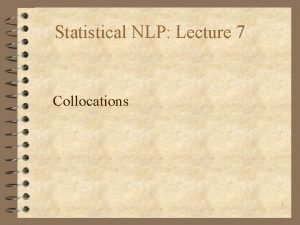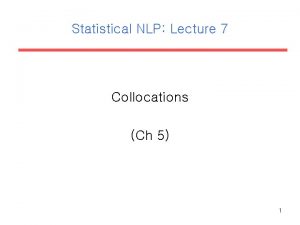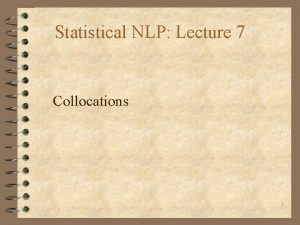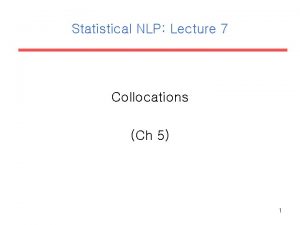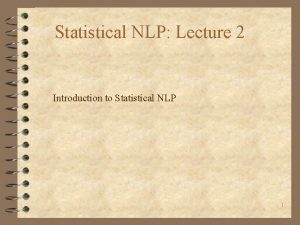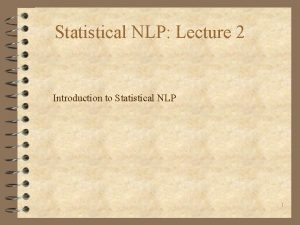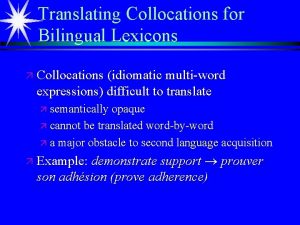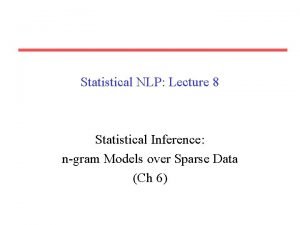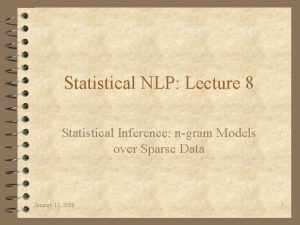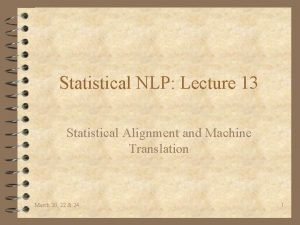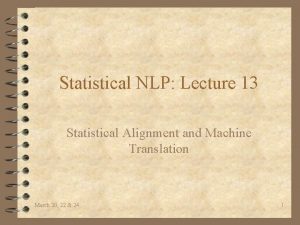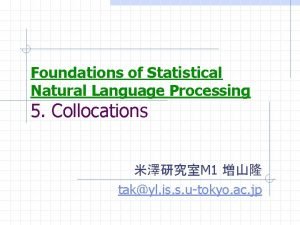Statistical NLP Lecture 7 Collocations Ch 5 1


![Definition (w. r. t Computational and Statistical Literature) • [A collocation is defined as] Definition (w. r. t Computational and Statistical Literature) • [A collocation is defined as]](https://slidetodoc.com/presentation_image_h2/e92c3792dce19d9eb6cde8e22af07c59/image-3.jpg)
















































- Slides: 51

Statistical NLP: Lecture 7 Collocations (Ch 5) 1

Introduction • Collocations are characterized by limited compositionality. • Large overlap between the concepts of collocations and terms, technical term and terminological phrase. • Collocations sometimes reflect interesting attitudes (in English) towards different types of substances: strong cigarettes, tea, coffee versus powerful drug (e. g. , heroin) • 미국 쪽은 관심이 적었으나, 영국 쪽은 많았음(Firth), contextual view • 신발 신다, 양복 입다 2
![Definition w r t Computational and Statistical Literature A collocation is defined as Definition (w. r. t Computational and Statistical Literature) • [A collocation is defined as]](https://slidetodoc.com/presentation_image_h2/e92c3792dce19d9eb6cde8e22af07c59/image-3.jpg)
Definition (w. r. t Computational and Statistical Literature) • [A collocation is defined as] a sequence of two or more consecutive words, that has characteristics of a syntactic and semantic unit, and whose exact and unambiguous meaning or connotation cannot be derived directly from the meaning or connotation of its components. [Chouekra, 1988] 3

Other Definitions/Notions (w. r. t. Linguistic Literature) • Collocations are not necessarily adjacent • Typical criteria for collocations: noncompositionality, non-substitutability, nonmodifiability. • Collocations cannot be translated into other languages. • Generalization to weaker cases (strong association of words, but not necessarily fixed occurrence. 4

Linguistic Subclasses of Collocations • Light verbs: verbs with little semantic content • Verb particle constructions or Phrasal Verbs • Proper Nouns/Names • Terminological Expressions 5

Overview of the Collocation Detecting Techniques Surveyed • Selection of Collocations by Frequency • Selection of Collocation based on Mean and Variance of the distance between focal word and collocating word. • Hypothesis Testing • Mutual Information 6

Frequency (Justeson & Katz, 1995) 1. Selecting the most frequently occurring bigrams 7

Frequency (Justeson & Katz, 1995) 2. Passing the results through a part-of speech filter: patterns likely to be phrases - A N, N N, A A N, N N N, N P N 8

Frequency (Justeson & Katz, 1995) strong vs. powerful Simple method that works very well. 9

Mean and Variance (I) (Smadja et al. , 1993) • Frequency-based search works well for fixed phrases. However, many collocations consist of two words in more flexible relationships. – {knock, hit, beat, rap} {the door, on his door, at the door, on the metal front door} • The method computes the mean and variance of the offset (signed distance) between the two words in the corpus. – a man knocked on Donaldson’s door (5) – door before knocked (-2), door that she knocked (-3) • If the offsets are randomly distributed (i. e. , no collocation), then the variance/sample deviation will 10 be high.

Mean and Variance (II) • • n = number of times two words collocate μ = sample mean di = the value of each sample Sample deviation: 11

예 • position of “strong” wrt “opposition” – 평균(d): -1. 15, 표준편차(s): 0. 67 12

예 • 9 이내의 collocation만 고려!!! • “strong” wrt “support” – strong leftist support • “strong” wrt “for” 13


Hypothesis Testing: Overview • High frequency and low variance can be accidental. We want to determine whether the cooccurrence is random or whether it occurs more often than chance. – new company • This is a classical problem in Statistics called Hypothesis Testing. • We formulate a null hypothesis H 0 (no association - only chance) and calculate the probability that a collocation would occur if H 0 were true, and then reject H 0 if p is too low. Otherwise, retain H 0 as possible. • 단순한 형태: p(w 1 w 2) = p(w 1)p(w 2) 15

Hypothesis Testing: The t-test • The t-test looks at the mean and variance of a sample of measurements, where the null hypothesis is that the sample is drawn from a distribution with mean m. • The test looks at the difference between the observed and expected means, scaled by the variance of the data, and tells us how likely one to get a sample of that mean and variance assuming that the sample is drawn from a normal distribution with mean μ. • To apply the t-test to collocations, we think of text corpus as a long sequence of N bigrams. 16

Hypothesis Testing: Formula 17


문서에서 • new companies – p(new) = 15828/14307688 – p(companies) = 4675/14307668 – H 0 : p(new companies) = p(new)*p(companies) => 3. 615*10 -7 – Bernoulli trial : p= 3. 615*10 -7 표준편차의 제곱은 p(1 -p)이 며 이는 p가 아주 작으므로 거의 p이다. – new companies는 8번 나타남 : 8/143076688 = 5. 591*10 -7 – t= (5. 591 – 3. 615)*10 -7/root(5. 591*10 -7/14307668) 0. 999932 – 표에서 찾으면 0. 005면 2. 576이며, 이보다 작으므로 null hypothesis를 부정하지 못함 19


Hypothesis testing of differences (Church & Hanks, 1989) • We may also want to find words whose cooccurrence patterns best distinguish between two words. This application can be useful for lexicography. • The t-test is extended to the comparison of the means of two normal populations. • Here, the null hypothesis is that the average difference is 0. 21

Hypothesis testing of difs. (II) 22

t-test for statistical significance of the difference between two systems 23

t-test for differences (continued) • Pooled s 2 = (1081. 6 + 1186. 9) / (10 + 10) = 113. 4 • For rejecting the hypothesis that System 1 is better then System 2 with a probability level of α = 0. 05, the critical value is t=1. 725 (from statistics table) • We cannot conclude the superiority of System 1 because of the large variance in scores 24

Chi-Square test (I): Method • Use of the t-test has been criticized because it assumes that probabilities are approximately normally distributed (not true, generally). • The Chi-Square test does not make this assumption. • The essence of the test is to compare observed frequencies with frequencies expected for independence. If the difference between observed and expected frequencies is large, then we can reject the null hypothesis of independence. 25

Chi-Square test (II): Formula 26

계산 – new companies는 null hypothesis를 부정 못 함 – 상위 20개의 t-scores와 x 2 는 같음!!! 27

Chi-Square test (III): Applications • One of the early uses of the Chi square test in Statistical NLP was the identification of translation pairs in aligned corpora (Church & Gale, 1991). • A more recent application is to use Chi square as a metric for corpus similarity (Kilgariff and Rose, 1998) • Nevertheless, the Chi-Square test should not be used in small corpora. 28


Likelihood Ratios I: Within a single corpus (Dunning, 1993) • Likelihood ratios are more appropriate for sparse data than the Chi-Square test. In addition, they are easier to interpret than the Chi-Square statistic. • In applying the likelihood ratio test to collocation discovery, we examine the following two alternative explanations for the occurrence frequency of a bigram w 1 w 2: – The occurrence of w 2 is independent of the previous occurrence of w 1 – The occurrence of w 2 is dependent of the previous occurrence of w 1 30

Log likelihood 31


Likelihood Ratios II: Between two or more corpora (Damerau, 1993) • Ratios of relative frequencies between two or more different corpora can be used to discover collocations that are characteristic of a corpus when compared to other corpora. • r(relative frequency ratio)은 간단히 구해짐 – r 1 = c 1(w)/N 1, r 2 = c 2(w)/N 2, r=r 1/r 2 (표 5. 13) • This approach is most useful for the discovery of subject-specific collocations. 33

Mutual Information (I) • An information-theoretic measure for discovering collocations is pointwise mutual information (Church et al. , 89, 91) • Pointwise Mutual Information is roughly a measure of how much one word tells us about the other. • Pointwise mutual information does not work well with sparse data. 34

Mutual Information (II) 35







Collocation에 대한 정리 42

Collocation에 대한 정리 43

Collocation에 대한 정리 44

Collocation에 대한 정리 45

Collocation에 대한 정리 46

Collocation에 대한 정리 47

Collocation에 대한 정리 48

Collocation에 대한 정리 49

Collocation에 대한 정리 50

Collocation에 대한 정리 51
 Collocations nlp
Collocations nlp Exhibition collocation
Exhibition collocation Lecture collocations
Lecture collocations Statistical natural language processing
Statistical natural language processing Natural language processing lecture notes
Natural language processing lecture notes Natural language processing
Natural language processing Natural language processing lecture notes
Natural language processing lecture notes Nlp lecture notes
Nlp lecture notes 01:640:244 lecture notes - lecture 15: plat, idah, farad
01:640:244 lecture notes - lecture 15: plat, idah, farad Make do collocations
Make do collocations What are collocations
What are collocations Correct the mis collocations in these sentences
Correct the mis collocations in these sentences Omonimi esempi
Omonimi esempi Contoh kata kolokasi
Contoh kata kolokasi Idiomatic collocations
Idiomatic collocations Rewrite the sentences again
Rewrite the sentences again Collocations keep
Collocations keep Collocations definition
Collocations definition Motivation collocations
Motivation collocations Flax corpus
Flax corpus Frozenness meaning
Frozenness meaning Classification of phraseological units
Classification of phraseological units Top down parsing in nlp
Top down parsing in nlp Discourse integration in nlp
Discourse integration in nlp Cs378 nlp
Cs378 nlp Uoupot
Uoupot Sheffield nlp
Sheffield nlp Computer vision vs nlp
Computer vision vs nlp Jape tutorial
Jape tutorial Information retrieval nlp
Information retrieval nlp 812007
812007 Dan jurafsky nlp
Dan jurafsky nlp Xxxxxdob
Xxxxxdob Markov chain nlp
Markov chain nlp Nlp toolkit python
Nlp toolkit python Nlp dimensionality reduction
Nlp dimensionality reduction Augmented transition network in nlp
Augmented transition network in nlp Nlp smoothing
Nlp smoothing Nlp training thailand
Nlp training thailand Semantic role labeling nlp
Semantic role labeling nlp Nlp infrastructure
Nlp infrastructure Weka nlp
Weka nlp Why is nlp hard in terms of ambiguity?
Why is nlp hard in terms of ambiguity? Nlp generative model
Nlp generative model Nlp login
Nlp login Example of cohesion
Example of cohesion 11-747 neural networks for nlp
11-747 neural networks for nlp Discourse integration in nlp
Discourse integration in nlp Sheffield nlp
Sheffield nlp Nlp berlin
Nlp berlin Annie nlp
Annie nlp Nlp chunking
Nlp chunking

